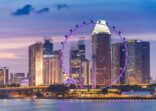Their AUM in Asia-Pacific increased at a five-year compound annual growth rate (CAGR) of 8.2%, taking the total to $726bn at the end of 2019, compared with $489bn at the start of 2015, according to Broadridge Financial, a US-based data and analytics firm.
In terms of size, mixed-asset products now comprise 20% of long-term funds available to investors in the region, behind single-asset equity and fixed income funds.
Taiwan showed the strongest five-year AUM CAGR at 33%, followed by Thailand at 21%, while Malaysia, Singapore and Japan also saw strong inflows. Hong Kong has seen a five-year CAGR of 4%, despite big outflows last year.
According a report last month by the Hong Kong Investment Funds Association, balanced or mixed assets funds experienced net sales of about $4bn, while fixed income funds enjoyed a bonanza year, attracting net inflows of $24.04bn.
Mixed asset rise
Yet, the constant search for yield and steady income amid volatile market conditions has given mixed-asset funds a boost, according to Yoon Ng, Broadridge’s senior director of Apac insights.
There are also several reasons for their rising popularity.
“These include their suitability for retirement savings, for instance in China which is introducing pension target-date funds, and in Japan and South Korea, which are gradually making life-cycle funds available,” Ng told FSA.
“In addition, the gradual shift from commission-led to fee-based advisory models, shown by a trend towards discretionary fund management by private banks, and the rising popularity of robo-advisors and fund wraps services, especially in China and Japan, has also benefited the sector,” she said.
Nevertheless, mixed-asset funds struggle to match the long-term returns of equity funds, and compete with high yield bonds funds to offer compelling levels of income.
For instance, mixed-asset funds (with Asia-Pacific investment mandates) authorised for sale to Hong Kong retail investors, achieved an average 13.47% cumulative return in the five years to the end of 2019, compared with a 25.41% average cumulative return by Asia-Pacific ex-Japan equity funds, according to FE Fundinfo data.
Nevertheless, the sector has several stand-out performers reporting cumulative returns of over 30%, according to FE Fundinfo.
These included the JP Morgan China Income Fund (35.73%), the Allianz Choice International Fund (34.25%), the First State Asian Bridge Fund (34.18%) and the Fidelity Advantage Portfolio Growth Fund (33.47%)
Also on the positive side, mixed-asset funds tend to be more stable. The average annualised volatility of the mixed-asset (Asia-Pacific) sector over the same five-year period is 9.73%, compared with 13.62% for Asia-Pacific ex-Japan equity funds.
However, there are differences in the composition of mixed-asset funds within the region.
For instance, in Japan “Reits are being used more widely in an effort to boost returns, as shown by top selling funds such as Tokio Marine JPY Asset Balance Fund with a typical allocation of 70% in bonds, 15% in stocks and 15% in Reits,” said Ng.
“In China on the other hand, most mixed-asset funds have an equity bias,” she said.
China traction
The top 10 best-selling multi-asset funds in the region last year had a one-year net return of at least 5% and most have monthly distribution features, according to Broadridge data.
These included two China products – the Foresight Growth Value Hybrid Fund and the AIFMC He Tai Hybrid Fund, which attracted net inflows of $1.44bn and $1.19bn respectively last year.
Although China was second-ranked in the region in terms of overall multi-asset AUM at $2.0trn, the CAGR to the end of 2019 was a meagre 0.8%.
However, amid volatile stock markets and an unstable economic environment, Chinese asset managers have been actively exploring multi-asset products for better diversification, and to meet investors’ increasing retirement investment needs, according to Ng.
“The [China] market is home to both the highest number of multi-asset funds of any market in Asia-Pacific, as well as the highest volume of new launches in this category in 2019,” she noted.
Domestic asset managers in China have been increasingly launching actively managed multi-asset products through “manager-of-manager” products, funds of funds, and other sub-advisory services. The diversification properties of funds of funds mean they offer similar benefits to multi-asset portfolios.
“New varieties of funds-of-funds and manager-of-manager [products] could spread in China to distribution channels such as the wealth management subsidiaries of banks and insurers, which are looking for external managers to help provide alternatives to replace traditional wealth management products,” said Ng.
Apac mixed-asset fund AUM CAGR, 2015-2019
| Country |
CAGR |
| Australia |
11% |
| China |
1% |
| Hong Kong |
4% |
| Indonesia |
4% |
| Japan |
14% |
| Malaysia |
16% |
| Singapore |
18% |
| South Korea |
-6% |
| Taiwan |
33% |
| Thailand |
21% |
| Apac Overall |
8% |
Source: Broadridge Financial. Includes local and cross-border funds.
Top 5 mixed-asset funds in Apac by net flows in 2019
| Fund name |
Country |
Net flows ($) |
| Tokio Marine JPY Asset Balance Fund |
Japan |
1.93bn |
| Tokio JPY Asset Balance Fund |
Japan |
1.47bn |
| Foresight Growth Value Hybrid Fund |
China |
1.44bn |
| AIFMC He Tai Hybrid Fund |
China |
1.19bn |
| SCB Income Plus Fund |
Thailand |
1.07bn |

















